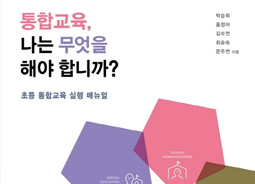
Quality-Indicator Based Inclusive Education: An Implementation Guide
Seung Hee Park (seunghee@ewha.ac.kr)
Department of Special Education

The concept of inclusive education involves the practice of including all students irrespective of talent, disability, socioeconomic background, or cultural origin in supportive schools and classrooms where all students’ needs are met. However, educators worldwide face challenges in practicing quality inclusive education that provides a diverse student body with access to have opportunities to achieve the highest potential. Therefore, evidence-based practice is required to enhance teaching strategies and promote shared responsibility, which will drive the necessary changes in current inclusive school practice.
This book is the first implementation guide for the quality-indicator based inclusive education for students with special education needs in Korea. While inclusive education has been a buzzword in the field of special education for the last 30 years in Korea, school professionals, support personnel and parents still need more practical guidelines to meet the best practice standard in inclusive education.
Not limited to special educators, general education teachers in inclusive schools should collaborate with professionals in other specific areas of expertise to fully meet all students’ unique and diverse educational needs. This implementation guide describes the different roles of five groups of stakeholders according to forty-six indicators of inclusive education (Park, Hong, & Choi, 2012). The five key stakeholder groups include general education teachers, special education teachers, school administrators, parents, and support personnel including paraprofessionals. In inclusive school communities, supporting students’ diverse educational needs and promoting a greater acceptance of students with disabilities should become a shared responsibility of all school professionals. Despite having differentiating roles and responsibilities, the five groups need to make collaborative efforts for the success of inclusive education implementation.
Thus, our objective is to provide the five groups with research-based tactics and strategies to improve the quality of inclusive education and to ultimately increase the achievement of all learners with diverse needs. This book is designed to enable the reader to quickly translate the best practice based on research findings into daily teaching in inclusive settings. The book addresses two unique but critical features: first, inclusive education indigenous to the current public schools and educational system in Korea; second, five groups’ role inventories and concrete guidelines for performing their roles according to the forty-six quality indicators of inclusive education. The forty-six indicators were derived from the original research on the fifty-five quality indicators with seven subareas of inclusive education that serve as a basis for starting, monitoring, and evaluating the implementation of inclusive education (Park et al., 2012). These indicators were originally developed for elementary inclusive schools but could be easily adaptable to secondary inclusive settings.
This implementation guide can be used as a practical compendium for practitioners of inclusive education. It is comprehensive but deliberately concise and is divided into two parts. Part 1, Chapters 1 to 3, builds the foundation for monitoring and evaluating inclusive education practices by using the quality indicators. Included in this part is coverage on the rationale for purpose and application of the quality indicators; an inclusive school’s self-evaluation procedure for the inclusive education practices and five stakeholders’ self-evaluation of their performances by using the quality indicators with the rating of 7-point Likert scale. Part 2, Chapters 4 to 9, introduces the reader to the inventories of five groups’ roles and responsibilities and performance guidelines that delineate “what” and “how” each of five groups needs to do to implement quality inclusive education. The final chapter emphasizes that the lists of five groups’ roles and performance guidelines need to be used as a minimum standard for the best practice and the need to strive for improvement of inclusive education in Korea in a more creative and sustainable manner. [Park, S. H., Hong, J., Kim, S., Choi, S., & Moon, J.(2019). Quality-indicator based inclusive education: An implementation guide. Seoul: Ewha Womans University Press.]
* Related Book & Article
Park, S. H. (2003). Korean inclusive education: Toward better alignment of special and general education. Seoul: Kyoyookkwahaksa.
Park, S. H., Hong, J. & Choi, S.(2012). Development and use of the quality indicators of inclusive education: Toward the evaluation of elementary inclusive education. Korean Journal of Special Education, 47, (10), 87-117.

